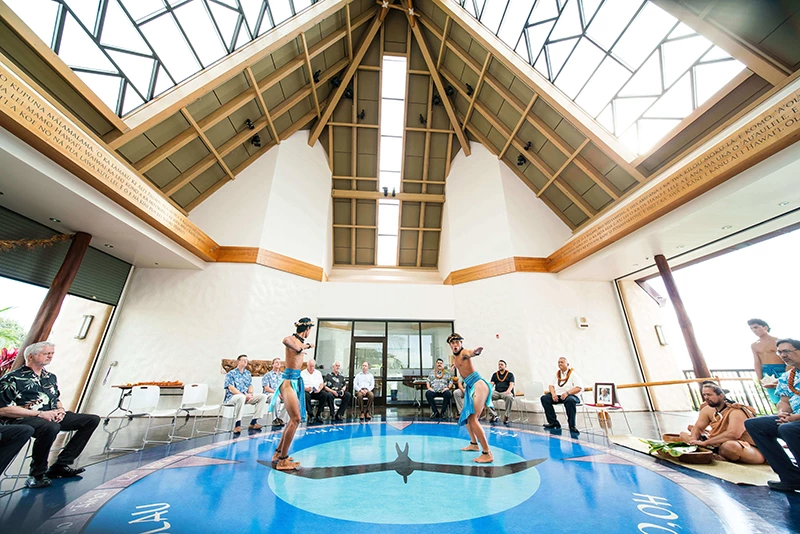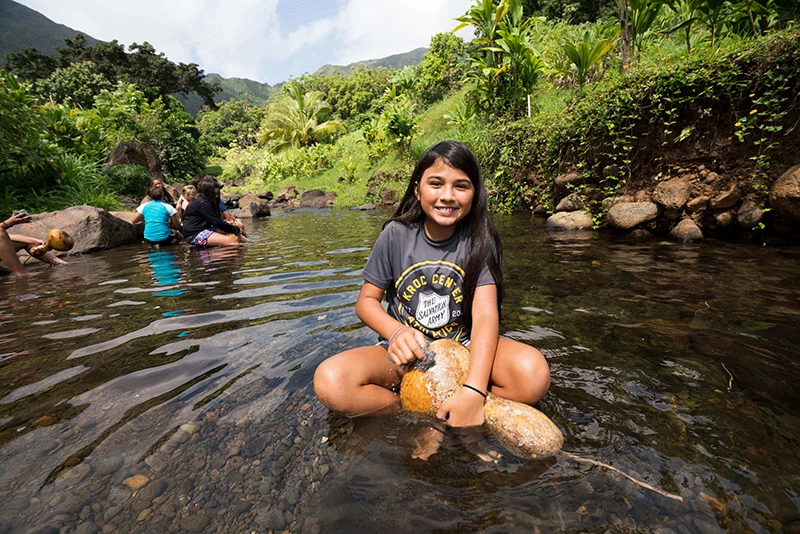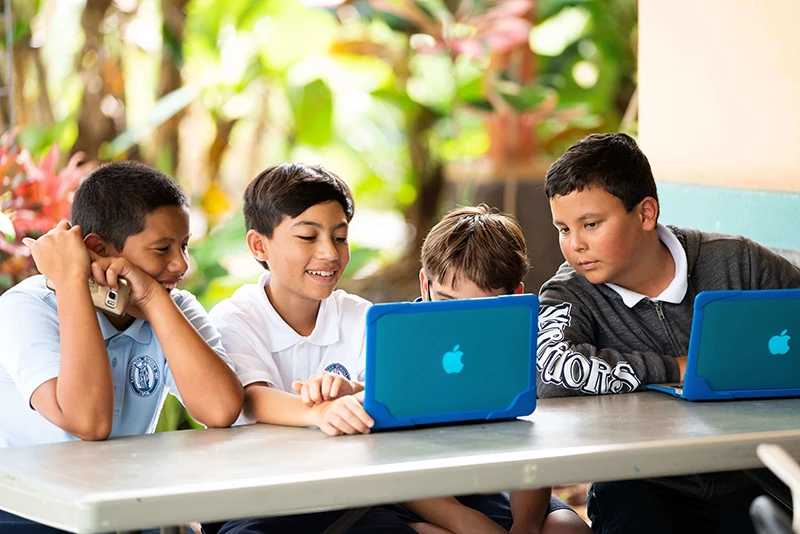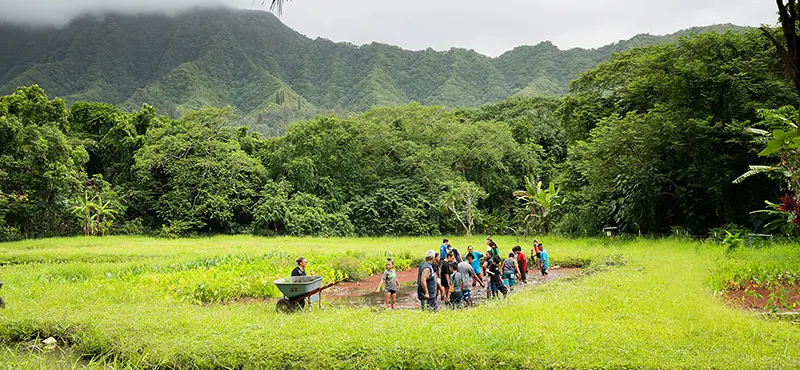Hōkūleʻa journeyed north of the United States as it arrived at Canada's Port of Yarmouth on July 31. Crew members were welcomed by the Nova Scotia community, dignitaries and members of the Mi'kmaw (pronounced "Meeg Maw") Nation on the Yarmouth dock, some who attended the occasion in traditional garb. The Mi'kmaw are part of the Wabanaki that Hōkūleʻa and her crew honored during the voyage's recent Portsmouth and Mt. Desert stops.
The celebratory arrival ceremony featured cultural dances and the rhythmic beating of drums. Feathers were presented by a representative of the Mi'kmaw to each Hōkūleʻa crew member as a symbol of peace and unity.
"This makes me believe that we're more alike than we're different. When we come here and you tell us to come to your place, and thank us for being here, and for being happy - that's aloha," said Nainoa Thompson, pwo (master) navigator and president of the Polynesian Voyaging Society, during the arrival ceremony.
"The Worldwide Voyage is trying to take this little canoe and aloha around the world, and we came to Yarmouth for that purpose.”
Chief Deborah Robinson of the Acadia First Nations (Mi'kmaw Nation) also spoke at the event. "The Mi'kmaw as part of the indigenous community of Canada, has always struggled and continue to strive to protect Mother Earth and all the natural resources for the future. The preservation of our environment and conservation of the resource is of utmost importance to us as the Mi'kmaw. We all have the same goal - in ensuring a future for our children, and for children for generations to come."
While in Canada, Hōkūleʻa crew members tried to learn more about cultural and environmental sustainability practices from the Bay of Fundy and the Southwest Nova Biosphere Reserve-a UNESCO-designated area that serves as a model for demonstrating a balanced relationship between humans and the environment.
The Hōkūleʻa crew is documenting and hopes share what they learn from the visit with students in classrooms throughout Hawaiʻi. They engaged with the area's First Nations, learn about Nova Scotia's natural resources and conservation efforts and offer canoe tours to the community.
During the journey, Mālama Honua Worldwide Voyage crew members found themselves at one of the most amazing natural sites in North America - the Bay of Fundy.
Nestled between the Canadian maritime provinces of New Brunswick and Nova Scotia, the Bay of Fundy is approximately 170 miles of rugged cliffs, booming ocean waves, and other awe-inspiring ecological elements. In 2014, an international panel of experts named the Bay of Fundy one of the natural wonders of the world due to the location having the highest tides on earth, attracting the rarest species of whales in the world, and housing semi-precious minerals and dinosaur fossils. The visit to the Bay of Fundy supports one of the objectives of the Mālama Honua Worldwide Voyage to seek out environmental stories of hope and highlight the importance of caring for Island Earth.
The Hōkūleʻa crew visited the area during a new moon cycle, a time when the tidal shifts are more spectacular.
Kalepa Baybayan, pwo (master navigator) and captain of Hōkūleʻa's current leg of the voyage, described their location. "It's the geography of the bay that really accentuates the tidal currents here. It's very wide at the mouth and very narrow at the end. There's also this thing called tidal resonance, where the water flows in from the mouth of the bay to the inland shore, matching the tidal period and that accentuates the tide."
Greg Turner, a tour guide and expert for the Bay of Fundy, further explained the natural activities in the area. "I think one of the most spectacular parts of that (natural) formation and many others around the Bay of Fundy is the fact that if you are standing on the ocean floor, you can imagine six hours from now being completely covered in water and all of (the area) being totally underwater."
Hōkūleʻa crew members were in the Nova Scotia area for about a week, engaging with the area's First Nations, learning about Canada's natural resources and conservation efforts and offering canoe tours to the community. The legendary voyaging canoe departed Yarmouth, Nova Scotia on Thursday, Aug. 4, and has returned to Mt. Desert, Maine. The crew plans to continue engagements in the US New England states as she sails back down to New York.
Kamehameha Schools is proud to be the Education Sponsor of the Hōkūleʻa Worldwide Voyage. For more information about the Polynesian Voyaging Society and the Worldwide Voyage, visit hokulea.com or find the society on Facebook, Twitter, Instagram, YouTube and Google+.
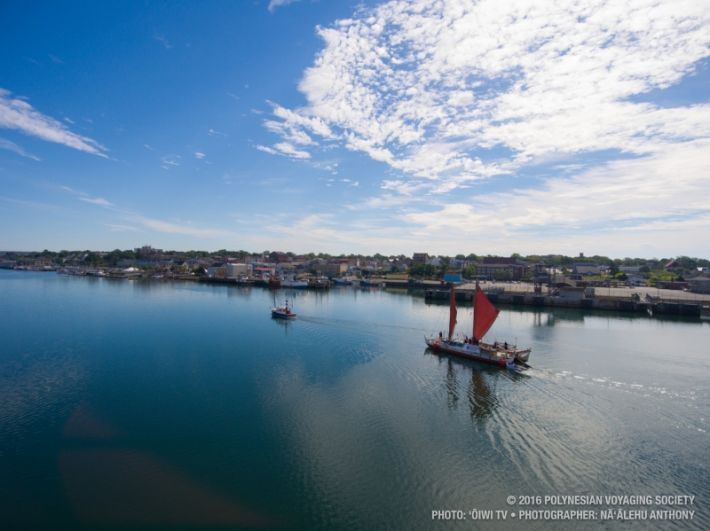
Hōkūleʻa arrives in Nova Scotia.

Crewmembers exchange gifts with members of the Mi'kmaw Nation in Port Yarmouth.

Master navigator Nainoa Thompson addresses the arrival ceremony.

The Bay of Fundy features a spectacular changing of tides.
TAGS
malama honua voyage
CATEGORIES
Kaipuolono Article, Newsroom, Department News, Ho‘okahua, Mālama Honua
Print with photos
Print text only

